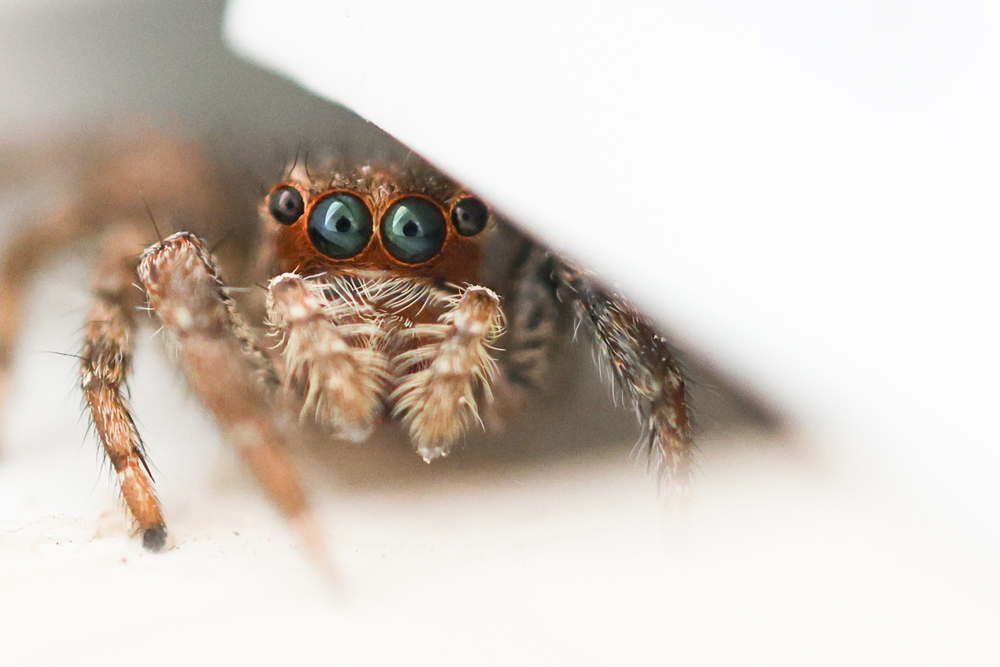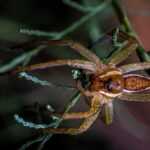Can Jumping Spiders Bite? Everything You Need to Know
Can jumping spiders bite? Yes, they can, but it’s rare and not dangerous to humans. This article covers when bites happen, their symptoms, and treatment options.
- Jumping spiders can bite humans, but such occurrences are rare and generally occur only when they feel threatened.
- Bites from jumping spiders are typically mild, comparable to mosquito bites, and not considered dangerous unless an allergic reaction occurs.
- Preventing jumping spider infestations involves sealing entry points, reducing outdoor vegetation near homes, and maintaining cleanliness inside.
Can Jumping Spiders Bite?
Yes, jumping spiders can bite humans, though it is a rare occurrence. Unlike more aggressive spider species, jumping spiders possess a non-aggressive nature and generally prefer to avoid confrontation. Bites typically happen only when these spiders feel threatened or trapped, acting primarily in self-defense.
Jumping spiders are known for their exceptional vision and agile movements, which they use to escape perceived threats rather than engage. Adult jumping spiders’ bites are not a common response; instead, they will often attempt to flee when disturbed. This behavior makes encounters with these spiders relatively safe compared to other more defensive species.
Despite their ability to bite, jumping spiders are not out to get you. They are more interested in hunting their insect prey than in biting humans. Understanding this can help alleviate some of the fear and misunderstanding surrounding these intriguing arachnids.
Are Jumping Spider Bites Dangerous to Humans?
If you are bitten by a jumping spider, the experience is typically less severe than a bee sting. Their venom, while effective for subduing small prey, is not considered harmful to humans. The symptoms of a jumping spider bite are generally mild, comparable to a mosquito bite, and may include a small welt, redness, itching, stinging, and swelling.
In the rare case of an allergic reaction, symptoms could be more severe, but such instances are uncommon. Jumping spider bites are not considered dangerous unless an allergic reaction occurs. For most people, the bite heals quickly without any complications.
Understanding the mild nature of jumping spider bites can help reduce unnecessary fear. While it’s wise to be cautious and monitor any symptoms, knowing that these bites are generally harmless can provide peace of mind.
How to Treat a Jumping Spider Bite
If you find yourself with a jumping spider bite, the first step is to clean the bite site thoroughly with soap and water. This helps prevent infection and removes any venom that may be present. Applying a cold compress to the area can help reduce swelling and alleviate pain.
In most cases, these simple steps are enough to treat a jumping spider bite effectively. However, if you notice any concerning symptoms or if you suspect an allergic reaction, it is crucial to seek medical attention promptly. Symptoms of an allergic reaction can include difficulty breathing, severe swelling, or anaphylaxis and require immediate medical intervention.
Healing from a jumping spider bite may take a bit longer than other insect bites, but with proper care, you can ensure a smooth recovery. Keeping the bite clean and monitoring your symptoms will help you manage the situation effectively.
Identifying Common Jumping Spiders
Several species of jumping spiders are commonly encountered, each with distinct characteristics. The bold jumping spider is one of the most common jumping spiders, with its black body, white or yellow markings, and large iridescent green or metallic-blue fangs. This striking appearance makes it easy to identify and fascinating to observe. For more information, check out our jumping spider faqs.
Another common species is the zebra jumping spider, named for its distinctive black and white striped pattern on its abdomen. These spiders are often found in grassy areas and are known for their agile hunting skills. Their contrasting stripes make them a unique and interesting species to spot.
The regal jumping spider stands out with its intricate metallic green, blue, and red pattern and large forward-facing eyes. Found commonly in wooded areas, particularly in the Southeastern United States, these spiders are a true spectacle of nature’s artistry.
Where Do Jumping Spiders Live?
Jumping spiders are incredibly adaptable and can inhabit a variety of ecosystems. They are found in:
- grasslands
- prairies
- open woodlands
- backyards
- gardens
- old fields
These spiders thrive in areas with plentiful vegetation and sunlight, making outdoor environments ideal for their hunting and living needs.
The regal jumping spider, for instance, is commonly found in wooded areas of the Southeastern United States. Zebra jumping spiders, on the other hand, typically inhabit grassy areas and are often seen on plant stems or leaves. Their adaptability also means they can be found on plants, walls, and within homes, particularly in areas that provide ample hiding spots and hunting grounds.
Knowing where jumping spiders live can help you appreciate their role in the ecosystem and manage their presence around your home effectively.
What Do Jumping Spiders Eat?
Jumping spiders are carnivorous creatures with a diet that primarily consists of insects. They are active hunters, using their quick and jerky movements to catch prey rather than spinning webs like many other spider species. Their diet includes a variety of insects and small spiders, as well as isopods and even bees.
These spiders are also known to scavenge leftover insect parts and may occasionally enjoy nectar and flower petals. This diverse diet helps them thrive in different environments and contributes to their role in controlling pest populations.
Knowing what jumping spiders eat can help you appreciate their contribution to maintaining ecological balance and controlling insect populations around your home.
Preventing Jumping Spider Infestations
Preventing a jumping spider infestation begins with sealing all potential entry points. This includes cracks and gaps around windows, doors, and utility pipes. Blocking these access points significantly reduces the likelihood of spiders entering your home.
Another effective strategy is to trim vegetation away from the exterior of your building. Jumping spiders often use these plants as pathways to gain entry indoors. Additionally, maintaining low moisture levels in and around your home can deter these spiders, as they prefer humid environments.
Keeping your living spaces tidy and decluttered minimizes hiding spots for jumping spiders, making it less likely for them to settle inside. Utilizing sticky traps can also help capture and monitor spider activity near potential entry points to prevent jumping spiders.
Consider ongoing professional services for long-term prevention to maintain a spider-free environment.
Professional Pest Control Services
For those dealing with persistent jumping spider infestations, professional pest control service offers a comprehensive solution. Experts begin with a thorough inspection and assessment to identify entry points and the specific spider species involved. This targeted approach ensures effective management of the infestation.
Professionals use safe and effective treatments to eliminate jumping spiders and prevent future infestations. Ongoing monitoring and maintenance are recommended to keep your home spider-free and address any new infestations promptly.
Jumping spiders, while capable of biting, are generally harmless to humans and play a crucial role in controlling insect populations. Understanding their behavior, identifying common species, and knowing how to treat bites can help you manage any encounters effectively. Preventative measures and professional pest control services can ensure your home remains free of unwanted spider guests.
Taking proactive steps to manage jumping spiders not only protects your home but also contributes to a balanced ecosystem. Whether you’re dealing with an infestation or simply curious about these fascinating creatures, the insights provided here will equip you with the knowledge you need.
Frequently Asked Questions
Do jumping spiders like to be held?
Jumping spiders may tolerate being held, with some even enjoying the interaction, but others can be shy. Handle them gently to minimize any risk of stress or biting.
Do jumping spiders bond with people?
Jumping spiders may not bond in the same way as pets like cats or dogs, but they can recognize humans and potentially develop trust. This suggests that a form of connection, albeit different, is possible between jumping spiders and people.
Is it safe to hold a jumping spider?
It is generally safe to hold a jumping spider, but it requires careful handling to avoid injuring them, as they are small and delicate. Using a soft bristle brush to gently coax the spider is advisable for their safety.
What happens if a jumping spider bites you?
If a jumping spider bites you, it typically results in mild symptoms like redness, itching, and swelling. To manage the bite, clean the area with soap and water and apply a cold compress.
Can jumping spiders bite humans?
Yes, jumping spiders can bite humans, but such incidents are rare and typically happen only when the spider feels threatened.




